A Multiple Rényi Entropy Based Intrusion Detection System for Connected Vehicles
Abstract
1. Introduction
Related Works
2. Preliminaries
2.1. Shannon Entropy and Rényi Entropy
2.2. Efficient Estimation of Rényi Entropy
2.3. Attack Models
3. Theoretical Analysis of Entropy with Respect to Attack Rate
3.1. Case 1: DoS Attack
3.2. Case 2: Fuzzy Attack
3.3. Proposed Algorithm for Estimation of Rényi Entropies with Orders 2, 3, and 4
| Algorithm 1: Proposed estimation of Rényi entropy with multiple orders 2, 3, and 4. |
 |
3.4. Improving Accuracy Using a Characterizing Attack Pattern with RSW
- Step 1.
- Generate an i-th block, , by accumulating CAN-IDs of the sequentially generated frames into the queue of CAN-IDs, , where is the size of a block.
- Step 2.
- Entropy related to the frequencies of the individual CAN-IDs accumulated in in Step 1 is evaluated.
- Step 3.
- By comparing the estimated entropy in Step 2 with the pre-specified normal entropy H, the first decision of whether is normal or abnormal is made. Denote for the normal block and otherwise.
- Step 4.
- Find the entropy change information , by comparing with according to the following rules:where .
- Step 5.
- is stored in the pattern queue .
- Step 6.
- Check whether the pattern of entropy change information s in fits into the rules specified according to the types of attacks, and whether the pattern matches with one of the rules. These blocks are treated as attack patterns, even if the result of the first decision is classified as normal traffic.
- Step 7.
- Otherwise, if there is no matching rule among the amount of consecutive s, blocks are removed from . In this case, the intrusion decision on the output blocks is determined by the results of the first decision.
- Step 8.
- CAN-IDs in the considered block slide (i.e., the number of blocks in a slide multiplied by ) are removed from .
4. Numerical Results
5. Conclusions
Author Contributions
Funding
Conflicts of Interest
References
- Koscher, K.; Czeskis, A.; Roesner, F.; Patel, S.; Kohno, T. Experimental security analysis of a modern automobile. In Proceedings of the 2010 IEEE Symposium on Security and Privacy, Berkeley/Oakland, CA, USA, 16–19 May 2010; pp. 447–462. [Google Scholar]
- Checkoway, S.; McCoy, D.; Kantor, B.; Anderson, D.; Shacham, H.; Savage, S. Comprehensive experimental analyses of automotive attack surfaces. In Proceedings of the 20th USENIX Security Symposium, San Francisco, CA, USA, 8–12 August 2011; p. 6. [Google Scholar]
- Miller, C.; Valasek, C. A Survey of Remote Automotive Attack Surfaces; Tech. Rep. 8; Black Hat USA: Las Vegas, NV, USA, 2014. [Google Scholar]
- Petit, J.; Shladover, S.E. Potential cyberattacks on automated vehicles. IEEE Trans. Intell. Transp. Syst. 2015, 16, 546–556. [Google Scholar] [CrossRef]
- Miller, C.; Valasek, C. Remote Exploitation of an Unaltered Passenger Vehicle; Tech. Rep. 23; Black Hat USA: Las Vegas, NV, USA, 2015. [Google Scholar]
- Fröschle, S.; Stühring, A. Analyzing the capabilities of the can attacker. In Proceedings of the 22nd European Symposium on Research in Computer Security, Oslo, Norway, 11–15 September 2017; Springer: Oslo, Norway, 2017; pp. 464–482. [Google Scholar]
- Liu, J.; Zhang, S.; Sun, W.; Shi, Y. In-vehicle network attacks and countermeasures: Challenges and future directions. IEEE Netw. 2017, 31, 50–58. [Google Scholar] [CrossRef]
- Marchetti, M.; Stabili, D. Read: Reverse engineering of automotive data frames. IEEE Trans. Inf. Forensics Secur. 2019, 14, 1083–1097. [Google Scholar] [CrossRef]
- Wu, W.; Li, R.; Xie, G.; An, J.; Bai, Y.; Zhou, J.; Li, K. A Survey of Intrusion Detection for In-Vehicle Networks. IEEE Trans. Intell. Transp. Syst. 2019. [Google Scholar] [CrossRef]
- Muter, M.; Asaj, N. Entropy-Based Anomaly Detection for In-Vehicle Networks. In Proceedings of the 2011 IEEE Intelligent Vehicles Symposium (IV), Baden-Baden, Germany, 5–9 June 2011. [Google Scholar]
- Narayanan, B.N.; Djaneye-Boundjou, O.; Kebede, T.M. Performance analysis of machine learning and pattern recognition algorithms for Malware classification. In Proceedings of the 2016 IEEE National Aerospace and Electronics Conference(NAECON) and Ohio Innovation Summit (OIS), Dayton, OH, USA, 25–29 July 2016; pp. 338–342. [Google Scholar]
- Kebede, T.M.; Djaneye-Boundjou, O.; Narayanan, B.N.; Ralescu, A.; Kapp, D. Classification of Malware programs using autoencoders based deep learning architecture and its application to the microsoft malware Classification challenge (BIG 2015) dataset. In Proceedings of the 2017 IEEE National Aerospace and Electronics Conference (NAECON), Dayton, OH, USA, 27–30 June 2017; pp. 70–75. [Google Scholar]
- Alom, M.Z.; Bontupalli, V.; Taha, T.M. Intrusion Detection using Deep Belief Networks. In Proceedings of the 2015 National Aerospace and Electronics Conference, (NAECON), Dayton, OH, USA, 16–19 June 2015; pp. 339–344. [Google Scholar]
- Callegari, C.; Giordano, S.; Pagano, M. Entropy-based network anomaly detection. In Proceedings of the 2017 International Conference Computing, Networking and Communications (ICNC), Silicon Valley, CA, USA, 26–29 January 2017; pp. 334–340. [Google Scholar]
- Callegari, C.; Giordano, S.; Pagano, M. Anomaly detection: An overview of selected methods. In Proceedings of the 2017 Int. Multi-Conference Engineering, Computer and Information Sciences (SIBIRCON), Novosibirsk, Russia, 18–24 September 2017; pp. 52–57. [Google Scholar]
- Saia, R.; Carta, S.; Recupero, D.R.; Fenu, G.; Stanciu, M.M. A Discretized Extended Feature Space (DEFS) Model to Improve the Anomaly Detection Performance in Network Intrusion Detection Systems. In Proceedings of the 11th International Joint Conference Knowledge Discovery, Knowledge Engineering and Knowledge Management, Vienna, Austria, 17–19 September 2019; pp. 322–329. [Google Scholar]
- Saia, R.; Salvatore, C.; Recupero, R. A Probabilistic-driven Ensemble Approach to Perform Event Classification in Intrusion Detection System. In Proceedings of the 10th International Joint Conference Knowledge Discovery, Knowledge Engineering and Knowledge Management, Seville, Spain, 18–20 September 2018. [Google Scholar]
- Berezinski, P.; Jasiul, B.; Szpyrka, M. An Entropy-Based Network Anomaly Detection Method. Entropy 2015, 17, 2367–2408. [Google Scholar] [CrossRef]
- Lee, H.; Jeong, S.H.; Kim, H.K. OTIDS: A Novel Intrusion Detection System for In-vehicle Network by using Remote Frame. In Proceedings of the 2017 IEEE 15th PST, Calgary, AB, Canada, 28–30 August 2017. [Google Scholar]
- Hazem, A.; Fahmy, H. Lcap-a lightweight can authentication protocol for securing in-vehicle networks. In Proceedings of the 10th Escar Embedded Security Cars Conference, Berlin, Germany, 28–29 November 2012; Volume 6, pp. 283–300. [Google Scholar]
- Macher, G.; Sporer, H.; Brenner, E.; Kreiner, C. Supporting cyber-security based on hardware-software interface definition. In Proceedings of the European Conference Software Process Improvement, Graz, Austria, 14–16 September 2016; Springer: Graz, Austria, 2016; pp. 148–159. [Google Scholar]
- Abbott-McCune, S.; Shay, L.A. Intrusion prevention system of automotive network can bus. In Proceedings of the IEEE International Carnahan Conference Security Technology (ICCST), Orlando, FL, USA, 24–27 October 2016; pp. 1–8. [Google Scholar]
- Eric, W.; William, X.; Suhas, S.; Songsong, L.; Kai, Z. Hardware module-based message authentication in intra-vehicle networks. In Proceedings of the ACM/IEEE 8th International Conference Cyber-Physical Systems (ICCPS), Pittsburgh, PA, USA, 18–20 April 2017; pp. 207–216. [Google Scholar]
- Bulck, J.V.; Mühlberg, J.T.; Piessens, F. VulCAN: Efficient component authentication and software isolation for automotive control networks. In Proceedings of the 33rd Annual Computer Security Applications Conference, Orlando, Florida, USA, 4–8 December 2017; pp. 225–237. [Google Scholar]
- Macher, G.; Sporer, H.; Brenner, E.; Kreiner, C. An automotive signal-layer security and trust-boundary identification approach. Procedia Comput. Sci. 2017, 109, 490–497. [Google Scholar] [CrossRef]
- Macher, G.; Sporer, H.; Brenner, E.; Kreiner, C. Signal-layer security and trust-boundary identification based on hardware-software interface definition. J. Ubiquitous Syst. Pervasive Netw. 2018, 10, 1–9. [Google Scholar] [CrossRef]
- Wang, Q.; Lu, Z.; Qu, G. An entropy analysis based intrusion detection system for controller area network in vehicles. In Proceedings of the 2018 31st IEEE International System-on-Chip Conference (SOCC), Washington, DC, USA, 4–7 September 2018; pp. 90–95. [Google Scholar]
- Kim, Y.-S. Low Complexity Estimation Method of Rényi Entropy for Ergodic Sources. Entropy 2018, 20, 657. [Google Scholar] [CrossRef]
- Rényi, A. On measures of entropy and information. In Proceedings of the Fourth Berkeley Symposium on Mathematical Statistics and Probability, Berkeley, CA, USA, 20 June–30 July 1960; pp. 547–561. [Google Scholar]
- CAN Dataset for Intrusion Detection (OTIDS). Available online: http://ocslab.hksecurity.net/Dataset/CAN-intrusion-dataset (accessed on 24 January 2020).
- Debar, H.; Dacier, M.; Wespi, A. Towards a taxonomy of intrusion-detection systems. Comput. Netw. 1999, 31, 805–822. [Google Scholar] [CrossRef]
- Cover, T.M.; Thomas, J.A. Elements of Information Theory; Wiley-Interscience: Hoboken, NJ, USA, 2006. [Google Scholar]
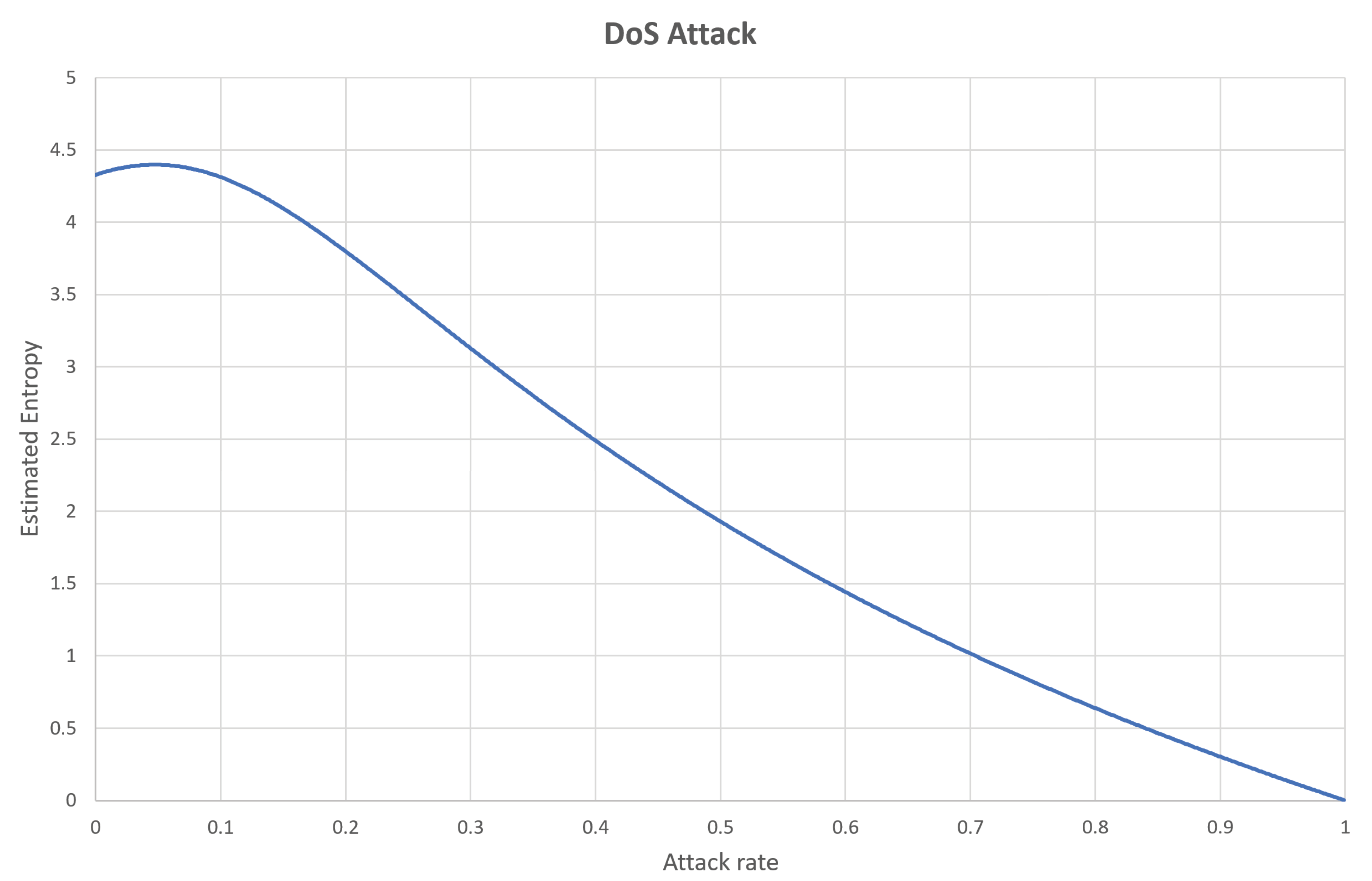
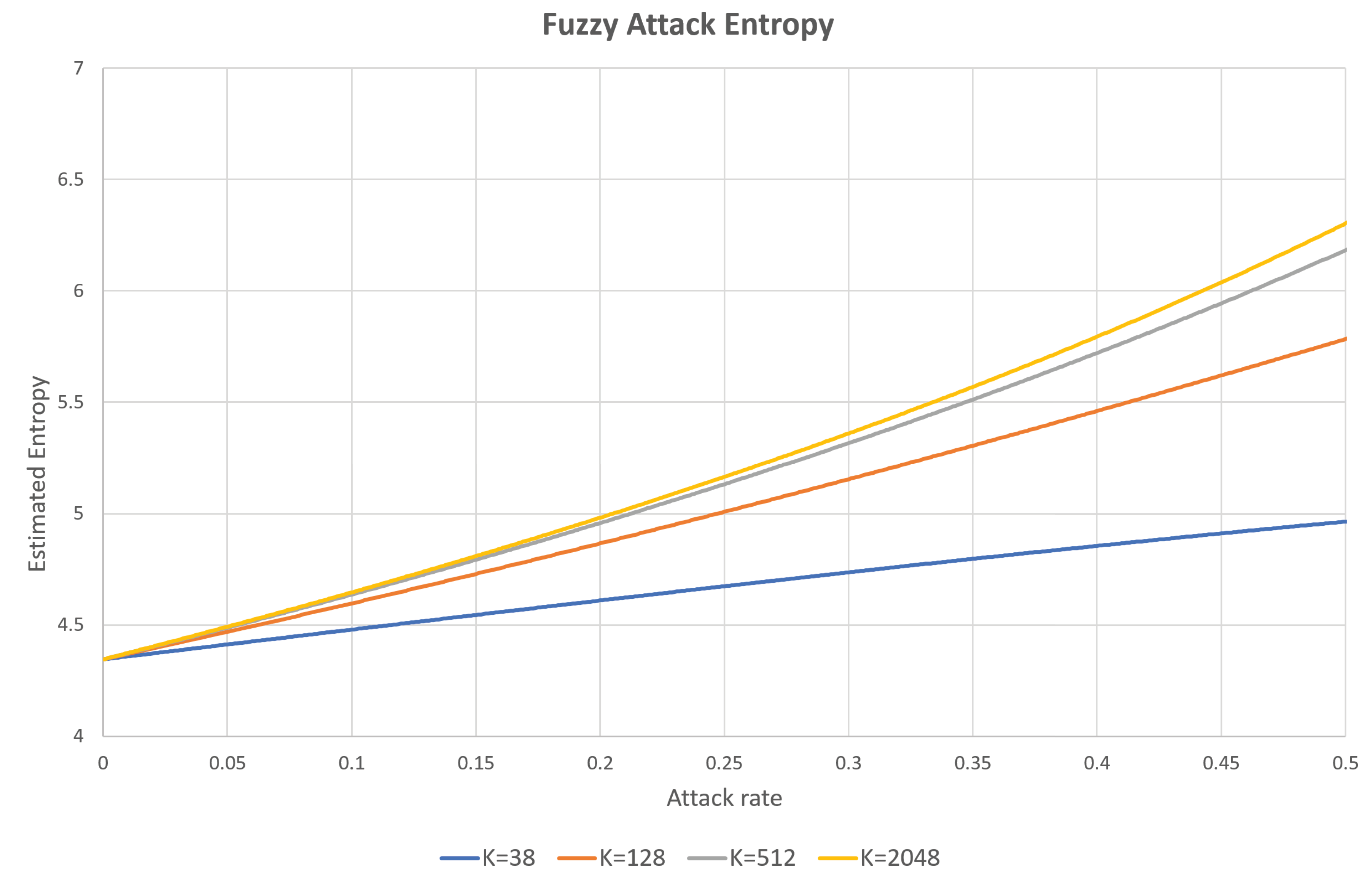
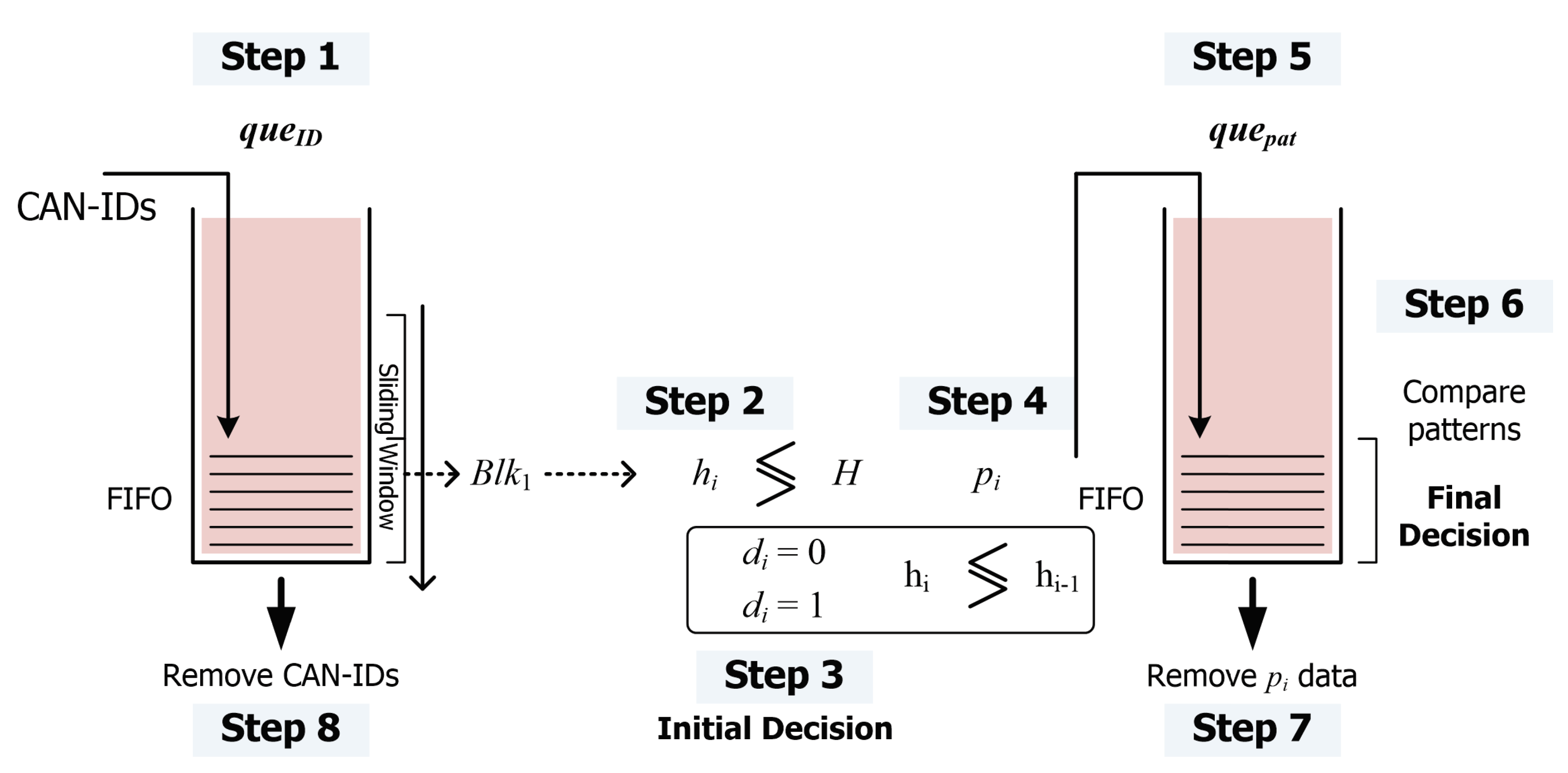

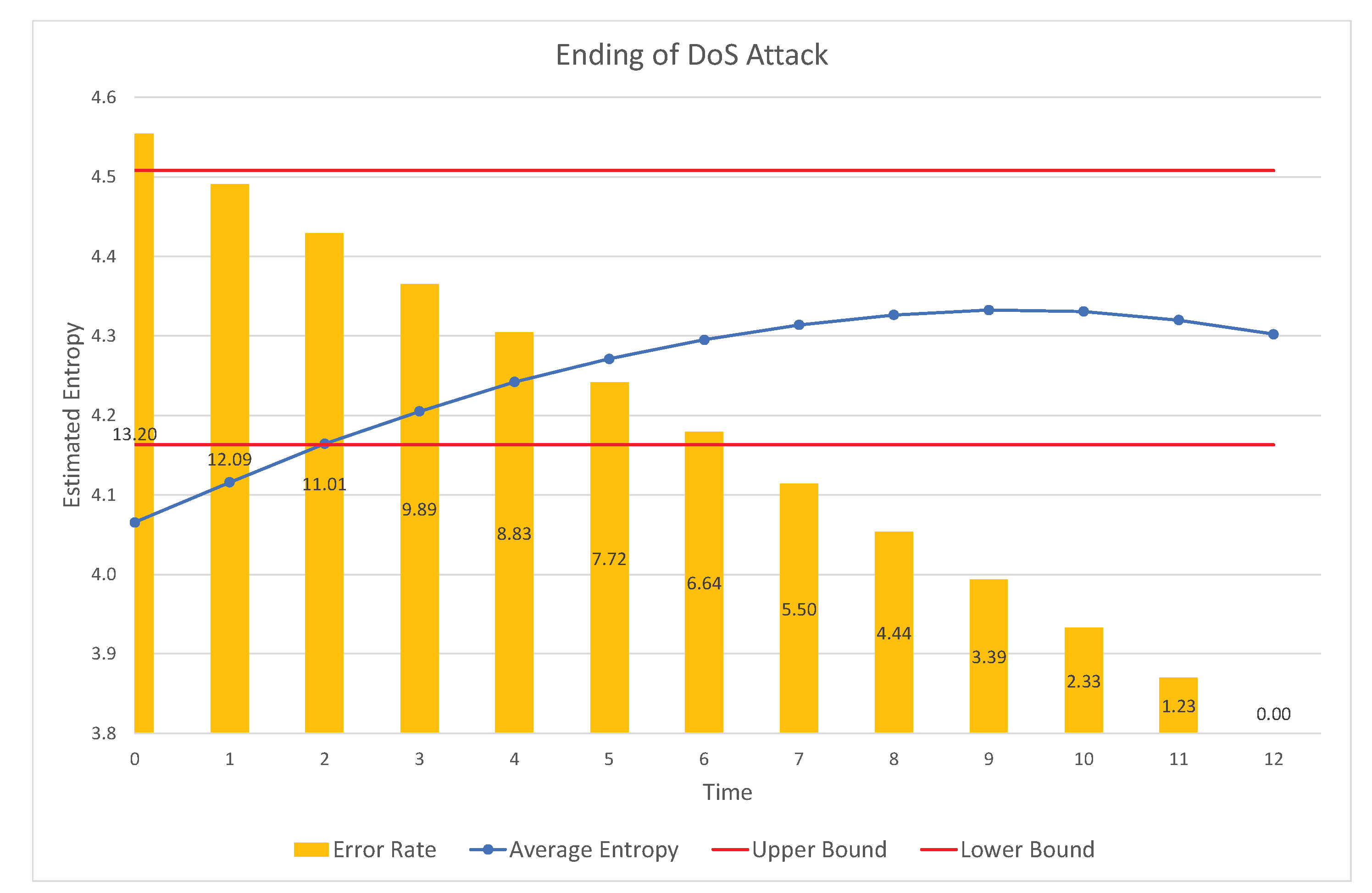
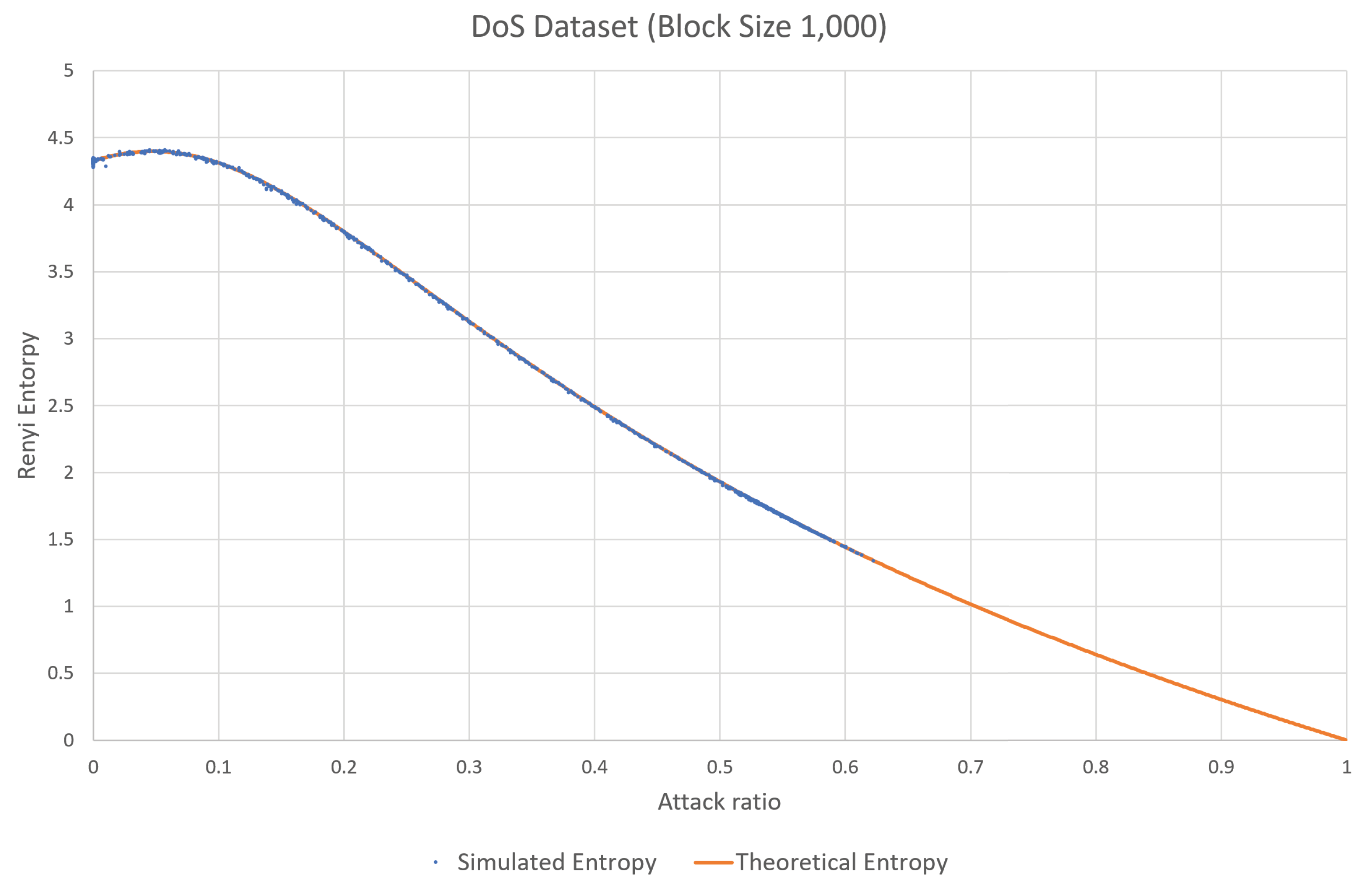
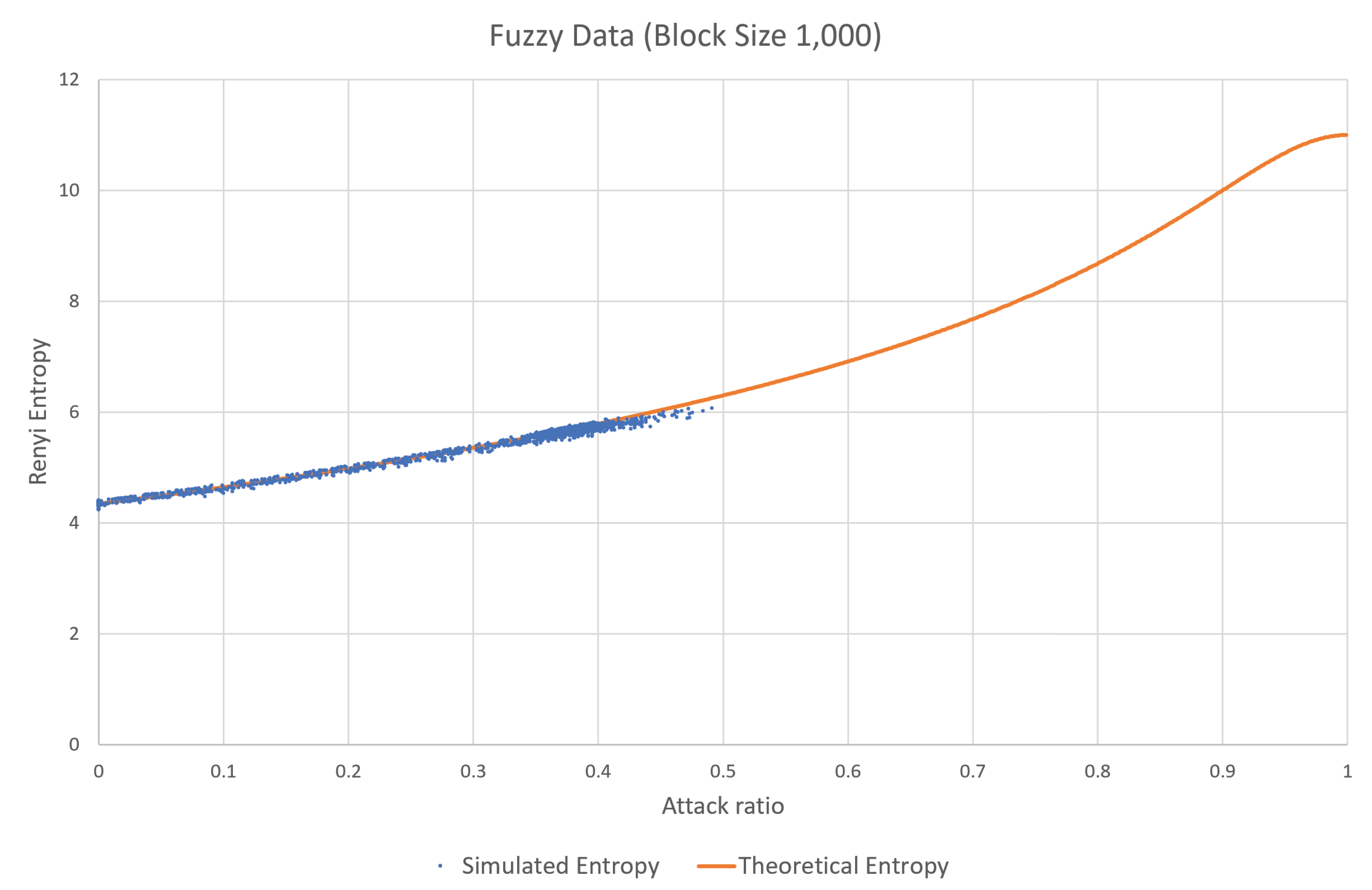

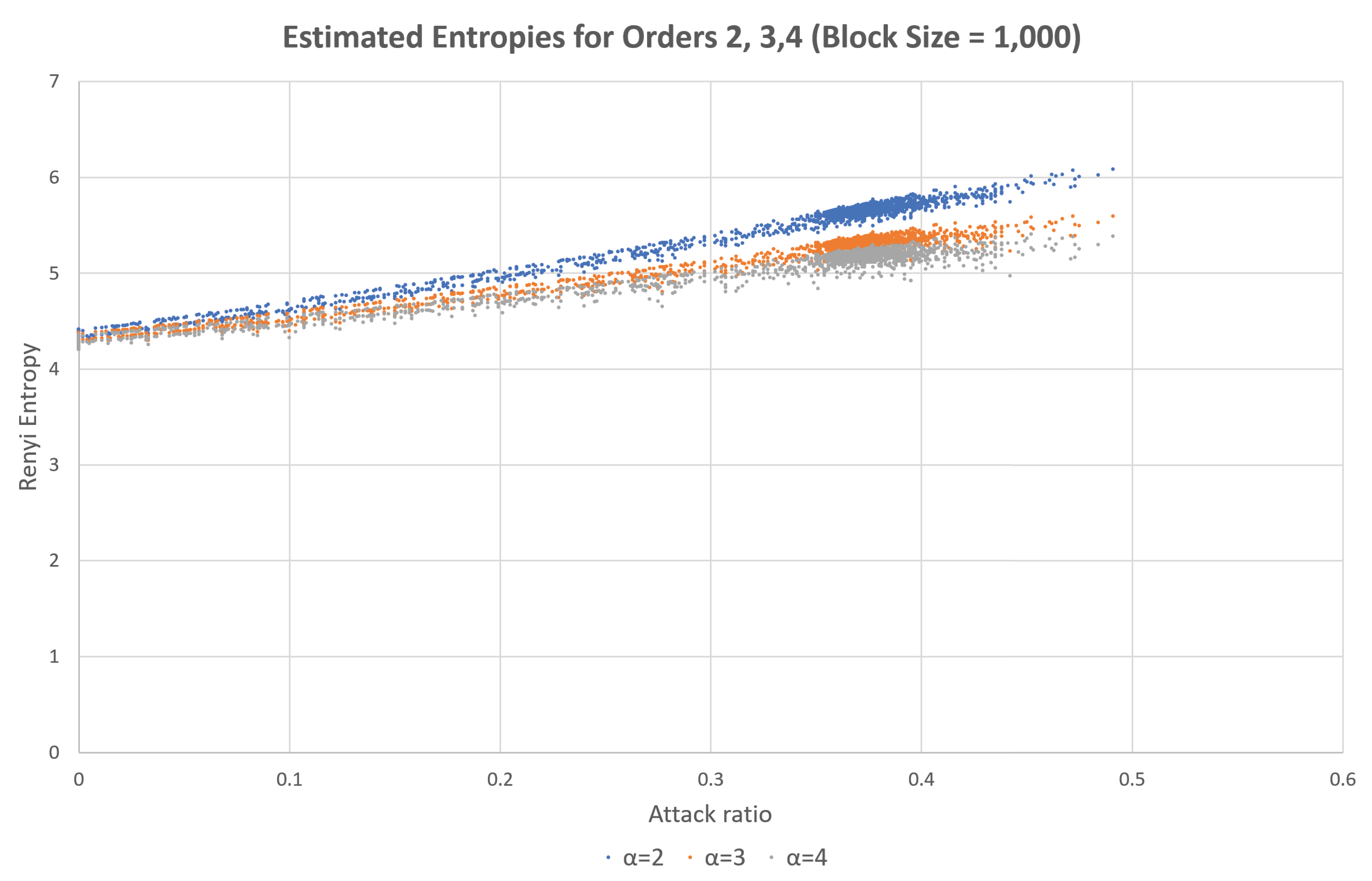
| DoS Attack | False Alarm | Missing |
| Entropy | 0.78 (100) % | 1.08 (100) % |
| Entropy + RSW | 0.79 (101.3)% | 0.49 (154.6)% |
| Fuzzy Attack | False Alarm | Missing |
| Entropy | 0.39 (100) % | 0.86 (100)% |
| Entropy + RSW | 0.41 (105.1)% | 0.58 (132.6)% |
© 2020 by the authors. Licensee MDPI, Basel, Switzerland. This article is an open access article distributed under the terms and conditions of the Creative Commons Attribution (CC BY) license (http://creativecommons.org/licenses/by/4.0/).
Share and Cite
Yu, K.-S.; Kim, S.-H.; Lim, D.-W.; Kim, Y.-S. A Multiple Rényi Entropy Based Intrusion Detection System for Connected Vehicles. Entropy 2020, 22, 186. https://doi.org/10.3390/e22020186
Yu K-S, Kim S-H, Lim D-W, Kim Y-S. A Multiple Rényi Entropy Based Intrusion Detection System for Connected Vehicles. Entropy. 2020; 22(2):186. https://doi.org/10.3390/e22020186
Chicago/Turabian StyleYu, Ki-Soon, Sung-Hyun Kim, Dae-Woon Lim, and Young-Sik Kim. 2020. "A Multiple Rényi Entropy Based Intrusion Detection System for Connected Vehicles" Entropy 22, no. 2: 186. https://doi.org/10.3390/e22020186
APA StyleYu, K.-S., Kim, S.-H., Lim, D.-W., & Kim, Y.-S. (2020). A Multiple Rényi Entropy Based Intrusion Detection System for Connected Vehicles. Entropy, 22(2), 186. https://doi.org/10.3390/e22020186





